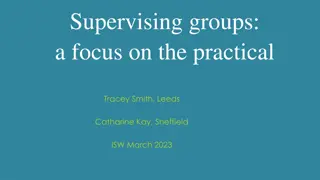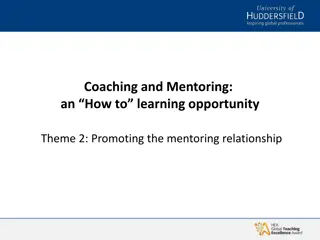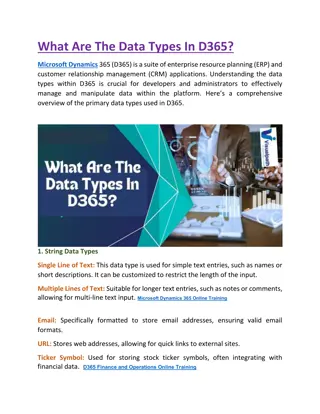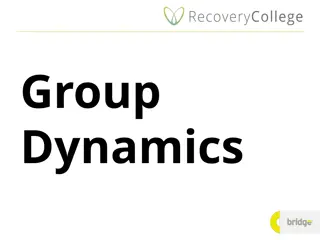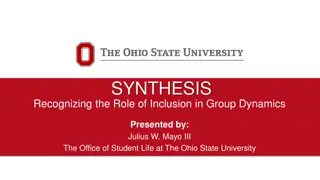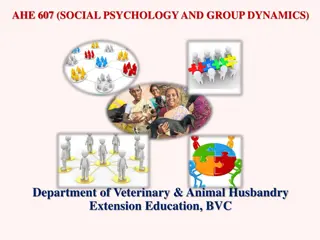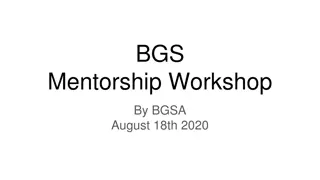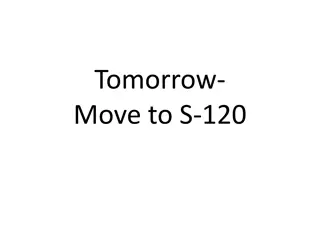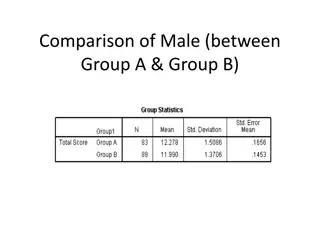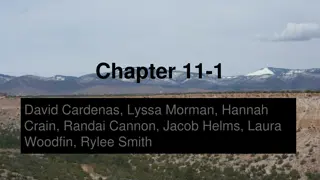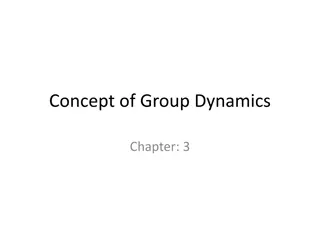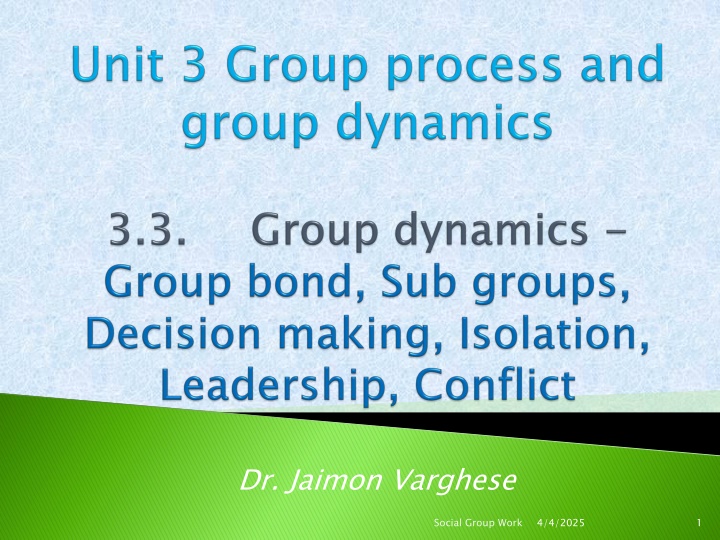
Understanding Group Dynamics in Social Work Practice
Explore the concept of group dynamics in social work, examining how interactions within a group influence its functioning. Learn about strategies for promoting positive group dynamics and addressing the impact of diverse backgrounds on members. Discover the four key dimensions of group dynamics and their significance in achieving group goals effectively.
Download Presentation

Please find below an Image/Link to download the presentation.
The content on the website is provided AS IS for your information and personal use only. It may not be sold, licensed, or shared on other websites without obtaining consent from the author. If you encounter any issues during the download, it is possible that the publisher has removed the file from their server.
You are allowed to download the files provided on this website for personal or commercial use, subject to the condition that they are used lawfully. All files are the property of their respective owners.
The content on the website is provided AS IS for your information and personal use only. It may not be sold, licensed, or shared on other websites without obtaining consent from the author.
E N D
Presentation Transcript
Dr. Jaimon Varghese Social Group Work 1 4/4/2025
Group dynamics A group can be characterised as a dynamic whole, that means, a change in the state of any subpart changes the state of any other subpart (Kurt Lewin, 1948:84) Social Group Work 2 4/4/2025
Group (Ronald W Toseland and Robert F Rivas, 1984:56-57) A system is made up of elements and their interactions. Task and treatment groups as social systems can be defined as people and their interactions, that are referred to as group process. The group process generates unique forces that influence group members as the group as whole. Group dynamics dynamics Social Group Work 3 4/4/2025
Group (Ronald W Toseland and Robert F Rivas, 1984:56-57) The forces generated by the group process are often referred to as group dynamics. Group dynamics refer to the properties that result from the group process, such as norms, roles and status hierarchies. Group dynamics dynamics Social Group Work 4 4/4/2025
Strategies for promoting helpful Group dynamics (Ronald W Toseland and Robert F Rivas, 2012:67-94) Identify group dynamics as they emerge during the ongoing group interaction Assess the impact of group dynamics on group members and the group as a whole Assess the impact of current group dynamics on future group functioning Strategies for promoting helpful Group dynamics Social Group Work 5 4/4/2025
Examine the impact of group dynamics on members from different racial / ethnic and socio economic backgrounds Facilitate and guide the development of group dynamics that lead to members satisfaction with their participation and that enable the group to achieve its goals Social Group Work 6 4/4/2025
Four dimensions of group dynamics: (Ronald W Toseland and Robert F Rivas, 2012:67-94) (1) Communication and interaction pattern (unit 3.2) (2) Cohesion (Group bond) (3) Social integration & influence (4) Group culture (unit 3.2) Four dimensions of group dynamics: Social Group Work 7 4/4/2025
Social integration & influence: (Ronald W Toseland and Robert F Rivas, 2012:81-82) Social integration refers to how members fit together, influence each other and are accepted in a group It builds unanimity about the purposes and goals of the group, helping members to move forward in an orderly & efficient manner. Norms and roles help social integration of the group Social integration & influence: Social Group Work 8 4/4/2025
Six elements of group dynamics (1) Group bond (2) Sub groups (3) Isolation (4) Conflict (5) Leadership (6) Decision making Six elements of group dynamics: Social Group Work 9 4/4/2025
(1) Group bond (cohesion) Group cohesion is the result of all forces acting on members to remain in a group (Festinger, 1950) Cohesion is made up of three components: (1) member to member attraction and a liking for the group as a whole; (2) a sense of unity and community so that the group is seen as a single entity; and (3) a sense of teamwork and spirit de corps with the group successfully performing as a coordinated unit (Forsyth, 2010). (1) Group bond (cohesion): Social Group Work 10 4/4/2025
Reasons for members attraction to the group: (Cartwright, 1968) The need for affiliation, recognition and security The resources and prestige available through group participation Expectations of the beneficial and detrimental consequences of the group The comparison of the group with other group experiences Social Group Work 11 4/4/2025
Principles for practice of cohesion: (Ronald W Toseland and Robert F Rivas, 2012:83) A high level of open interaction promotes cohesiveness When members needs are met, they want to continue participating Achieving group goals makes the group more attractive to its members Noncompetitive intragroup relationships that affirm members perceptions and points of view increase group cohesion Social Group Work 12 4/4/2025
Competitive intergroup relationships help to define a group s identity and purpose, thereby heightening members cohesion A group that is too large can decrease members attraction to the group by obstructing their full participation When members expectations are understood and addressed, group cohesion increases Groups that offer rewards, resources, status or prestige tend to be attractive Pride in being a member of a group can increase cohesion Social Group Work 13 4/4/2025
(2) Sub groups (Ronald W Toseland and Robert F Rivas, 2012:75-76) Subgroups form naturally from the emotional bonds and interest alliances among subsets of group members They help make the group attractive, because members look forward to interact with those who are close to them Worker intervenes if the attraction within the subgroup is found to be greater than the attraction towards group as a whole (2) Sub groups: Social Group Work 14 4/4/2025
Types of Sub groups (Ronald W Toseland and Robert F Rivas, 2012:75-76) Dyad close group of two Triad close group of three Clique close group of more than three members Isolates no interaction with group Scapegoats receives negative attentions and criticism from group Types of Sub groups: Social Group Work 15 4/4/2025
Committees or delegate council: when the group is too large, subcommittees are intentionally formed to accomplish specific tasks Challenges of subgroup formation: Sometimes subgroups challenge the worker or leader They may substitute their own goals and methods in place of group goals They may communicate among themselves & fail to listen to other members Social Group Work 16 4/4/2025
Strategies to manage subgroups: Examine whether the group as a whole is sufficiently attractive Promote norms on members listening to & respecting each other Promote norms restricting communication to one member at a time Change seating arrangements Social Group Work 17 4/4/2025
Ask for certain members to interact more frequently with other members Use programme materials and exercises that separate (break) subgroups Assign tasks to do in groups composed of members different from their subgroups Social Group Work 18 4/4/2025
(3) Isolation (IGNOU, 2020: Block 2, Unit 1, p.7) A kind of subgroup formation Members get isolated due to their unique sociocultural characteristics, personality differences, poor communication skills, or offensive behaviour patterns They are neglected by the group They remain indifferent to other members in the group Worker intervenes to integrate them (3) Isolation: (IGNOU, 2020: Block 2, Unit 1, p.7) Social Group Work 19 4/4/2025
(4) Conflict ( (Pallassana & Thomas,1983:168 Whenever two or more individuals interact with each other over a period of time, differences are bound to emerge. There is a possibility that differences around issues, opinions, priorities, values & needs can escalate into conflict Conflicts are often perceived as unpleasant and hostile differences between two or more parties (4) Conflict: Pallassana & Thomas,1983:168- -178) 178) Social Group Work 20 4/4/2025
Paradox is that growth, progress and excellence can not be attained by maintained the status-quo Change is an absolute must for growth, which will not only disrupt the balance, but also give rise and / or recognize conflicts. Conflict is a necessary contributing factor for progress Social Group Work 21 4/4/2025
However, there are conflicts detrimental to the group functioning, management of which requires worker s attention 3 kinds of conflicts: Intrapsychic conflicts emerging in the therapeutic relationship between the member & the worker Interpersonal conflicts between the members Allogenic conflicts as member group identifications and intergroup tensions (discomforts arising from person-group- societal interdependence) 3 kinds of conflicts: Social Group Work 22 4/4/2025
Allogenic conflicts: Leader self-disclosure & authenticity Process vs. content Problem solving or clarification Professional vs. personal values Group composition: heterogenous or homogenous Re-education vs. therapy Here & now vs. there & then Allogenic conflicts: Social Group Work 23 4/4/2025
Conflict resolution: (Gisela Konopka, 1963:64) (1) Withdrawal of one part of the group (2) Subjugation (3) Majority rule (4) Minority consent to majority rule (5) Compromise (6) Integration Conflict resolution: Social Group Work 24 4/4/2025
Conflict resolution: (Ronald W Toseland and Robert F Rivas, 1984:262-263) (1) Help members to recognize the conflict. (2) Help members to express the reasoning behind conflicting opinions and alternatives. (3) Develop facts and expert judgements to help resolve the conflict. (4) Emphasize those factors in the group discussion that promote consensus. (5) Follow orderly, pre-planned steps for considering alternatives and deciding on a solution. Conflict resolution: Social Group Work 25 4/4/2025
(6) Use decision criteria that are mutually agreed upon by group members. (7) Clarify and summarize the discussion frequently so that all members have a similar understanding of what is being discussed and the decision criteria that will be used. (8) Be sensitive to members personal concerns and needs in developing solutions and arriving at a decision. (9) Remain neutral in the conflict, asking questions that seek clarification whenever possible Social Group Work 26 4/4/2025
(5) Leadership (Ronald W Toseland and Robert F Rivas, 2012:97-158) Leadership is the process of guiding the development of the group & its members Two fold goals of effective leadership: Help the group & its members to achieve goals (task leadership) Meet the socioemotional needs of members (relationship leadership) (5) Leadership: Social Group Work 27 4/4/2025
Leadership tasks Task leadership: Define group structure Setting standards Identify roles Plan & coordinate activities Propose solutions Monitor compliance Stress the need for efficiency & productivity Leadership tasks: (Yukl, 2002) Task leadership: Social Group Work 28 4/4/2025
Relationship leadership Give support & encouragement Boost morale Establish rapport Show concern & consideration Reduce tension & conflicts Leadership is reciprocal, transactional, transformational, cooperative, & adaptive process involving members (Forsyth, 2010) Relationship leadership: (Yukl, 2002) Social Group Work 29 4/4/2025
Powerbases of leaders (Ronald W Toseland and Robert F Rivas, 2012:100) Connection power (influential position) Expert power (knowledge) Information power (data base) Legitimate power (group worker) Reference power (role model) Reward power (ability to reward) Coercive power (ability to punish) Powerbases of leaders: Social Group Work 30 4/4/2025
Leadership interventions ( (Pallassana & Thomas,1983:235 Warmth, empathy & genuineness Self-disclosure Confrontation Humour Exploration Summarising Support Cognitive restructuring Leadership interventions Pallassana & Thomas,1983:235- -280) 280) Social Group Work 31 4/4/2025
Role playing Use of programming Sequencing Timing Partializing Clarification Universalisation Modelling Work with individuals, group & environment Social Group Work 32 4/4/2025
(6) Decision making Decision making is a leadership function Decisions are taken from the beginning till the end of the group through its stages of formation, performance and termination Decisions are taken regarding the structure and process of the group (6) Decision making: Social Group Work 33 4/4/2025
Participation in decision making by leaders & members in groups using three leadership skills (Ronald W Toseland and Robert F Rivas, 2012:102) Participation in decision making by leaders & members in groups using three leadership skills: Social Group Work 34 4/4/2025
Decision can be taken alone or by a group depending upon the time, nature of the problem and situation Merits of Group Decisions While taking the decisions an individual has limited knowledge, capability, ideas and alternatives. More heads are better than one. Group decisions are based on more knowledge, experiences and information of several members of the group which improves the quality of decision. It also takes into account more alternatives Merits of Group Decisions ( (IGNOU, 2020: Unit 12, p.12) IGNOU, 2020: Unit 12, p.12) Social Group Work 35 4/4/2025
As more people are involved in the decision making process, it develops we feeling among the members, which ultimately enhances the commitment, satisfaction and participation level of members to implement the decision Group decision facilitates personality development and awareness of the members of the group about the on going activities of the agency, so that, they might implement the decision whole heartedly in order to achieve the group as well as the agency goals Social Group Work 36 4/4/2025
Limitations of Group Decisions ( (IGNOU, 2020: Unit 12, p.12) It is time consuming to arrive at a consensus when decision is to be taken by the group due to complexity of the problems, personality differences and politics within the group. Confidentiality may not be maintained in case of group decisions Limitations of Group Decisions IGNOU, 2020: Unit 12, p.12) Social Group Work 37 4/4/2025
Group decision can be dominated by a few members, which ultimately affects its spirit and effectiveness. In group decision, no body likes to share any responsibility, that is why sometimes it comes out to be a heartless, ineffective and delayed decision. The problem of group think where members may avoid to be too harsh towards the fellow member could also hinder the group decision making. It is possible when the group is more cohesive. Social Group Work 38 4/4/2025
(Ronald W Toseland and Robert F Rivas, 1984:260-261) The superiority of group has been less consistently documented when the task to be accomplished is of a more intellectual nature, such as a logic problem While groups are better than the average individual, they are not better than the best individual. Therefore, a group of novices may perform worse than one expert. Groups have the advantage of the wide variety of opinions and knowledge, but group members may censor controversial opinions. Social Group Work 39 4/4/2025
Accuracy may be affected by averaging the decision of non-interacting individuals. When groups solve intellectual tasks, members rational information processing orientation may be impeded by socio- emotional concerns. Because task groups require the time of a number of members who deliberate until they reach a decision, task groups may be more costly than work done by one or more individual working alone Social Group Work 40 4/4/2025
Cartwright, D. (1968). The nature of group cohesiveness. In Cartwright, D. & Zender, A. (Eds.). Group dynamics research and theory. (3rd ed., pp. 91-109). New York: Harper & Row. Festinger L. (1950). Informal social communication. Psychological, 57, 271-282. Forsyth, D.R. (2010). Group Dynamics (5th ed.). Belmont CA: Wadsworth Cengage Learning. IGNOU (2020) MSW 008 - Social Group Work: Working with Groups (rev. ed.). New Delhi: School of Social Work, Indira Gandhi National Open University Konopka Gisela (1963) Social Group Work A Helping Process, Englewood Cliffs, NJ: Prentice Hall Inc. Social Group Work 41 4/4/2025
Kurt Lewin (1948) Resolving Social Conflict, New York: Harper Pallassana R. Balgopal & Vassil V. Thomas (1983) Groups in Social Work An ecological perspective, New York: Macmillan Publishing Co. Toseland Ronald W and Rivas Robert F (1984) An Introduction to Group Work Practice, New York: McMillan Publishing Company Toseland W. Ronald & Rivas F. Robert (2012) An Introduction to Group Work Practice (7th Ed.). Boston: Allyn & Bacon Yukl, G. (2002). Leadership in organizations. Upper Saddle River, NJ: Prentice Hall Social Group Work 42 4/4/2025
Social Group Work 43 4/4/2025

